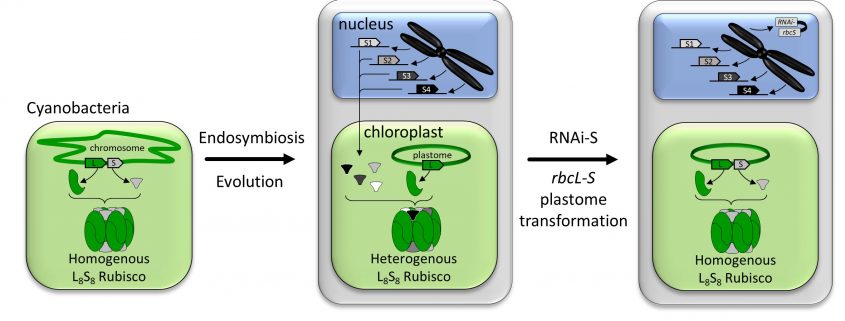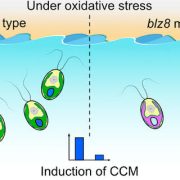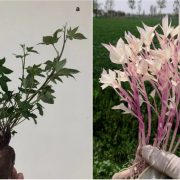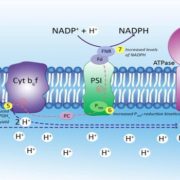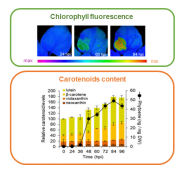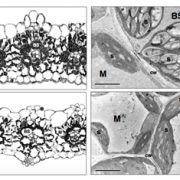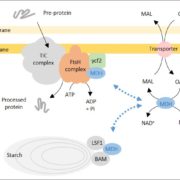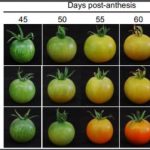Back to the Future for Plant Rubisco Bioengineering
Martin-Avila et al. use synthetic biology to improve photosynthesis in tobacco by swapping out the endogenous small subunits of Rubisco for one coming from potato, among other things. Plant Cell https://doi.org/10.1105/tpc.20.00288
By Spencer Whitney, Elena Martin-Avila, Sally Buck, Timothy Rhodes, Robert Sharwood (The Australian National University), Maxim Kapralov (Newcastle University, UK) and Lynnette Dirk (University of Kentucky, USA).
Background: A strategy for improving crop production is to increase the rate of carbon assimilation, by enhancing the CO2-fixing properties of the photosynthetic enzyme Rubisco, located in leaf chloroplasts. Plant Rubisco is a 16-protein complex that comprises a central core of 8 large subunits and two sets of 4 small subunits capping each end of the core. Although catalysis occurs within sites located in the L8 core, small subunit interactions with the large subunits provide both structural stability and influence the CO2-fixation properties of Rubisco. Attempts to improve Rubisco function have been encumbered by the differing genome locations of its encoding genes; the large subunit rbcL gene being in the chloroplast genome (plastome), the multiple small subunit RbcS genes in the nucleus.
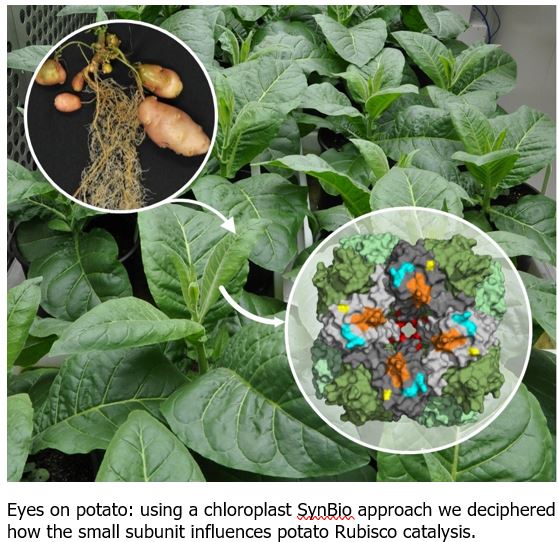 Question: We sought to develop a single step gene transformation strategy that re-located a rbcS gene back next to the rbcL gene in the plastome of a tobacco line where nuclear rbcS expression had been erased. The resulting homogeneous Rubisco produced would only comprise chloroplast-made large and small subunits, allowing us to test how amino acid substitutions affect catalysis.
Question: We sought to develop a single step gene transformation strategy that re-located a rbcS gene back next to the rbcL gene in the plastome of a tobacco line where nuclear rbcS expression had been erased. The resulting homogeneous Rubisco produced would only comprise chloroplast-made large and small subunits, allowing us to test how amino acid substitutions affect catalysis.
Findings: By silencing nuclear rbcS in tobacco, we produced a new plant chassis for bioengineering Rubisco by transforming custom-designed rbcL–rbcS operons into the plastome. Using this gene modification process, we showed the critical importance of optimizing operon design and rbcS genetic code to ensure compatibility with the protein translational machinery of chloroplasts. We tested this new bioengineering tool by producing four tobacco lines expressing different combinations of potato Rubisco small subunits. Analysis of the differing photosynthetic physiologies and Rubisco kinetics among each tobacco line allowed us to pinpoint amino acid differences in the small subunit that can improve potato Rubisco catalysis, although they also slightly impaired its assembly.
Next Steps: Future challenges include genetically optimizing the bioengineering process to increase Rubisco production to wild-type levels and replicate the chloroplast rbcL–rbcS co-transformation procedure in crops. This long-sought-after transformation capability will facilitate the introduction of improved Rubisco isoforms either synthesized by directed evolution or discovered in nature to address the question: can improving Rubisco enhance plant growth and yield?
Elena Martin-Avila, et al. (2020). Modifying Plant Photosynthesis and Growth via Simultaneous Chloroplast Transformation of Rubisco Large and Small Subunits. Plant Cell DOI: https://doi.org/10.1105/tpc.20.00288.


